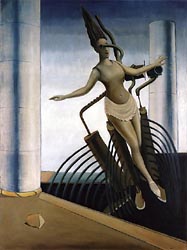To mark the start of London’s Alternative Fashion Week today’s picture is The Wavering Woman, by the Surrealist artist Max Ernst. A fashion victim for the Machine Age, the protagonist of Ernst’s bizarre fantasy advances precariously along a catwalk that also turns out to be an abyss. She has been locked into a contraption of ingeniously strange design, part article of couture, part instrument of torture. Whether she wears it, or it wears her, is a moot point. She stretches her arms out to either side, as if walking a tightrope. Her mechanical encumbrance has tubular arms of its own, one of which reaches up to cover her eyes. She is not enjoying the experience, to judge by her open-mouthed expression of alarm. Her hair stands on end.
Ernst painted the picture in Paris in 1923, when he was in his early thirties. His training had not been conventional. His father, an amateur artist, had taught him to paint during his upbringing in the small Prussian town of Bruhl, but had also vigorously discouraged him from pursuing art as a vocation. Ernst subsequently attended Bonn University, where he studied philosophy and psychiatry, among other subjects. Then the First World War intervened. He served in the German army from 1914-1918, an experience which he was to describe as his “first death”. “Max Ernst died on 1 August 1914,” he later recalled. “He experienced his rebirth on 11 November 1918 as a young man who was out to become a magician and discover the myth of his era.”
Ernst’s “rebirth” was intimately related to the overpowering feelings of revulsion awoken in him by the experience of war. He felt that it was his destiny to furnish a world gone wrong with appropriately unsettling images of its own instability. He was profoundly...

ITP 100: The Wavering Woman by Max Ernst
17-03-2002

